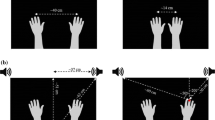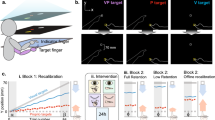Abstract
With a visual memory of where our hands are, their perceived location drifts. We investigated whether the perceived location of one hand or the spacing between two hands drifts in the absence of visual memories or cues. In 30 participants (17 females, mean age 27 years, range 20–45 years), perceived location of the right index finger was assessed when it was 10 cm to the right or left of the midline. Perceived spacing between the index fingers was assessed when they were spaced 20 cm apart, centred on the midline. Testing included two conditions, one with ten measures at 30 s intervals and another where a 3 min delay was introduced after the fifth measure. Participants responded by selecting a point on a ruler or a line from a series of lines of different lengths. Overall, participants mislocalised their hands closer to the midline. However, there was little to no drift in perceived index finger location when measures were taken at regular intervals (ipsilateral slope: 0.073 cm/measure [\(-0.014\) to 0.160], mean [99% CI]; contralateral slope: 0.045 cm/measure [\(-0.033\) to 0.120]), or across a 3 min delay (ipsilateral: (\(-0.47\) cm [\(-1.11\) to 0.17]; contralateral: \(-0.44\) cm [\(-1.12\) to 0.24]). There was a slight drift in perceived spacing when measures were taken at regular intervals (slope: \(-0.15\) cm/measure [\(-0.29\) to \(-0.01\)]), but none across a 3 min delay (0.08 cm [\(-1.08\) to 1.24]). Thus, proprioceptive-based perceptions of where our hands are located or how they are spaced drift minimally or not at all, indicating these perceptions are stable.



Similar content being viewed by others
Data and code availability
Data and related code are available from: https://github.com/MartinHeroux/EBR_proprio_drift
References
Abdulkarim Z, Ehrsson HH (2018) Recalibration of hand position sense during unconscious active and passive movement. Exp Brain Res 236:551–561
Bellan V, Gilpin HR, Stanton TR, Newport R, Gallace A, Moseley GL (2015) Untangling visual and proprioceptive contributions to hand localisation over time. Exp Brain Res 233:1689–1701
Brown LE, Rosenbaum DA, Sainburg RL (2003) Limb position drift: implications for control of posture and movement. J Neurophysiol 90:3105–3118
Butler AA, Héroux ME, van Eijk T, Gandevia SC (2019) Stability of perception of the hand’s aperture in a grasp. J Physiol 597:5973–5984
Chambers C, Fernandes H, Kording KP (2019) Policies or knowledge: priors differ between a perceptual and sensorimotor task. J Neurophysiol 121:2267–2275
Cumming G, Calin-Jageman R (2017) Introduction to the new statistics: estimation, open science, and beyond. Routledge, New York
Curran-Everett D (2017) CORP: minimizing the chances of false positives and false negatives. J Appl Physiol 122:91–95
Desmurget M, Rossetti Y, Jordan M, Meckler C, Prablanc C (1997) Viewing the hand prior to movement improves accuracy of pointing performed toward the unseen contralateral hand. Exp Brain Res 115:180–186
Desmurget M, Vindras P, Grea H, Viviani P, Grafton ST (2000) Proprioception does not quickly drift during visual occlusion. Exp Brain Res 134:363–377
Dijkerman HC, de Haan EH (2007) Somatosensory processes subserving perception and action. Behav Brain Sci 30:189–201
Foley JM, Held R (1972) Visually directed pointing as a function of target distance, direction, and available cues. Percept Psychophys 12:263–268
Fuchs X, Riemer M, Diers M, Flor H, Trojan J (2016) Perceptual drifts of real and artificial limbs in the rubber hand illusion. Sci Rep 6:24362
Gandevia SC, Rothwell JC (1987) Knowledge of motor commands and the recruitment of human motoneurons. Brain 110:1117–1130
Ghilardi MF, Gordon J, Ghez C (1995) Learning a visuomotor transformation in a local area of work space produces directional biases in other areas. J Neurophysiol 73:2535–2539
Haggard P, Newman C, Blundell J, Andrew H (2000) The perceived position of the hand in space. Percept Psychophys 62:363–377
Héroux ME, Walsh LD, Butler AA, Gandevia SC (2013) Is this my finger? Proprioceptive illusions of body ownership and representation. J Physiol 591:5661–5670
Héroux ME, Bayle N, Butler AA, Gandevia SC (2018) Time, touch and temperature affect perceived finger position and ownership in the grasp illusion. J Physiol 596:267–280
Holmes NP, Snijders HJ, Spence C (2006) Reaching with alien limbs: visual exposure to prosthetic hands in a mirror biases proprioception without accompanying illusions of ownership. Percept Psychophys 68:685–701
Horch KW, Clark FJ, Burgess PR (1975) Awareness of knee joint angle under static conditions. J Neurophysiol 38:1436–1447
Ingram LA, Butler AA, Walsh LD, Brodie MA, Lord SR, Gandevia SC (2019) The upper limb physiological profile assessment: description, reliability, normative values and criterion validity. PLoS One 14:e0218553
Jeannerod M (1988) The neural and behavioural organization of goal-directed movements. Oxford University Press, Oxford
Jones SA, Cressman EK, Henriques DY (2010) Proprioceptive localization of the left and right hands. Exp Brain Res 204:373–383
Knill DC (2005) Reaching for visual cues to depth: the brain combines depth cues differently for motor control and perception. J Vis 5:103–115
Kuling IA, Brenner E, Smeets JB (2016) Errors in visuo-haptic and haptic-haptic location matching are stable over long periods of time. Acta Psychol (Amst) pp 31–36
Kuling IA, de Bruijne WJ, Burgering K, Brenner E, Smeets JBJ (2019) Visuo-proprioceptive matching errors are consistent with biases in distance judgments. J Mot Behav 51:572–579
Lateiner JE, Sainburg RL (2003) Differential contributions of vision and proprioception to movement accuracy. Exp Brain Res 151:446–454
Lee W, Kelso J (1979) Properties of slowly adapting joint receptors do not readily predict perception of limb position. J Hum Mov Stud 5:171–181
Longo MR, Schüür F, Kammers MP, Tsakiris M, Haggard P (2008) What is embodiment? A psychometric approach. Cognition 107:978–998
Ventura de Oliveira JR, Romano-Silva MA, Ugrinowitsch H, Apolinario-Souza T, Fernandes LA, Parma JO, Lage GM (2019) Cathodal tDCS of the left posterior parietal cortex increases proprioceptive drift. J Mot Behav 51:272–280
Paillard J, Brouchon M (1968) Active and passive movements in the calibration of position sense. In: Freedman S (ed) The neuropsychology of spatially oriented behavior. Dorsey, Homewood, IL, pp 37–55
Patterson JR, Brown LE, Wagstaff DA, Sainburg RL (2017) Limb position drift results from misalignment of proprioceptive and visual maps. Neuroscience 346:382–394
Proske U, Gandevia SC (2012) The proprioceptive senses: their roles in signaling body shape, body position and movement, and muscle force. Physiol Rev 92:1651–1697
Proske U, Gandevia SC (2018) Kinesthetic senses. Compr Physiol 8:1157–1183
Qureshi HG, Butler AA, Kerr GK, Gandevia SC, Héroux ME (2018) Effects of horizontal distance and limb crossing on perceived hand spacing and ownership: differential sensory processing across hand configurations. Sci Rep 8:17699
Qureshi HG, Butler AA, Kerr GK, Gandevia SC, Héroux ME (2019) The hidden hand is perceived closer to midline. Exp Brain Res 237:1773–1779
Rincon-Gonzalez L, Buneo CA, Helms Tillery SI (2011) The proprioceptive map of the arm is systematic and stable, but idiosyncratic. PLoS One 6:e25214
Rohde M, Di Luca M, Ernst MO (2011) The rubber hand illusion: feeling of ownership and proprioceptive drift do not go hand in hand. PLoS One 6:e21659
Rossetti Y, Stelmach G, Desmurget M, Prablanc C, Jeannerod M (1994) The effect of viewing the static hand prior to movement onset on pointing kinematics and variability. Exp Brain Res 101:323–330
Rothwell JC, Traub MM, Day BL, Obeso JA, Thomas PK, Marsden CD (1982) Manual motor performance in a deafferented man. Brain 105:515–542
Samad M, Chung AJ, Shams L (2015) Perception of body ownership is driven by Bayesian sensory inference. PLoS One 10:e0117178
Tillery SI, Flanders M, Soechting JF (1991) A coordinate system for the synthesis of visual and kinesthetic information. J Neurosci 11:770–778
Tsay A, Savage G, Allen TJ, Proske U (2014) Limb position sense, proprioceptive drift and muscle thixotropy at the human elbow joint. J Physiol 592:2679–2694
Tsay A, Allen TJ, Proske U (2016) Position sense at the human elbow joint measured by arm matching or pointing. Exp Brain Res 234:2787–2798
van Beers RJ, Sittig AC, Denier van der Gon JJ (1996) How humans combine simultaneous proprioceptive and visual position information. Exp Brain Res 111:253–261
van Beers RJ, Sittig AC, Gon JJ (1999a) Integration of proprioceptive and visual position-information: an experimentally supported model. J Neurophysiol 81:1355–1364
van Beers RJ, Sittig AC, Denier van der Gon JJ (1999b) Localization of a seen finger is based exclusively on proprioception and on vision of the finger. Exp Brain Res 125:43–49
van Beers RJ, Wolpert DM, Haggard P (2002) When feeling is more important than seeing in sensorimotor adaptation. Curr Biol 12:834–837
Wann JP, Ibrahim SF (1992) Does limb proprioception drift? Exp Brain Res 91:162–166
Wilson ET, Wong J, Gribble PL (2010) Mapping proprioception across a 2D horizontal workspace. PLoS One 5:e11851
Wittkopf PG, Lloyd DM, Johnson MI (2017) Changing the size of a mirror-reflected hand moderates the experience of embodiment but not proprioceptive drift: a repeated measures study on healthy human participants. Exp Brain Res 235:1933–1944
Author information
Authors and Affiliations
Corresponding author
Additional information
Communicated by Winston D. Byblow.
Publisher's Note
Springer Nature remains neutral with regard to jurisdictional claims in published maps and institutional affiliations.
This work was supported by the National Health and Medical Research Council (https://www.nhmrc.gov.au/), APP1055084.
Rights and permissions
About this article
Cite this article
Rana, A., Butler, A.A., Gandevia, S.C. et al. Judgements of hand location and hand spacing show minimal proprioceptive drift. Exp Brain Res 238, 1759–1767 (2020). https://doi.org/10.1007/s00221-020-05836-5
Received:
Accepted:
Published:
Issue Date:
DOI: https://doi.org/10.1007/s00221-020-05836-5




